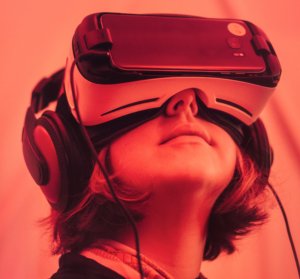I am afraid of Virtual Reality – Op Ed
FinanceFeeds’ Managing Editor is afraid of putting on a VR helmet. Probably, she should not be.

Virtual reality technologies are fast spreading around various areas of life and work, including online trading. The two most recent examples from the world of fintech come from Swissquote Group Holding SA (SWX:SQN) and GMO Click Securities, a part of GMO Click Holdings Inc (TYO:7177). Both companies have launched innovative applications for online trading in the virtual world – trading with one’s eyes is now officially possible.
Mainstream media is full of frightening reports of the side effects of using VR helmets and spending time in the virtual world. The scare has its name: VR-induced symptoms and effects (VRISE) and you will hardly encounter this term on the websites of companies that offer VR products – some warnings are, however, available on the product package and in user manuals.
Being an overly cautious (and curious) creature all of my life, I decided that before I hit the VR world, I would check the risks the way I’ve always done it – by reading books (in this case – scientific papers). The amount of studies of the “ VR side effects” (VRISE) is huge – the rise in such research has been particularly evident since the ’90s. There have been hundreds of VR-dedicated experiments in strictly controlled environments.
Cybersickness
After spending time in VR, many people (scientists call participants in experiments “subjects”) report feeling “sea sick”. This effect has not been fully tackled even now, mainly because it is physiologically programmed in our bodies. In VR, my vision indicates that I am moving, but in actual reality, my vestibular senses do not register movement. My brain gets confused and this nasty feeling may persist for hours after I get out of the VR.
The good news – this is not valid for all people. I am often told to think of it as a car ride – some feel sick in cars, others – not. But that does not make us prohibit cars.
Another good news – the human brain is able to adapt and after several entries into the VR, cybersickness may go away.
The bad news – all experiments thus far show that a minimal percentage (around 3-5%) of subjects continue to feel “sea sick” in the face of repeated use of a VR device. Some of them refuse to use it again even when incentivized (with cash) to do so.
Vection
This is the powerful illusion of self-motion. Those who experience it in VR, are likely to experience sickness after that. Given that online trading does not involve much movement, this problem can be easily downplayed.
However, complex environments including complex images and various textures may increase the vection effects. Online trading environment should be as neat as possible in the VR space.
FOV
FOV (or Field of View) is the extent of the observable environment in VR. I thought: “The bigger, the better.” And I was right – for the VR experience, but not for the after effects. The bigger the FOV, the deeper the immersion and the harder the recovery after that. And yes, there are people who may suffer from nasty side effects even if the FOV is smaller.
This does not mean that all display characteristics are correlated in this way to any after effects. High resolution and certain flicker frequency do improve VR experience and do not have any adverse impact on anyone’s health. In fact, contemporary technologies do reduce some of the nasty VR after-effects.
Posture
VR may have negative effects on one’s posture but studies have not been conclusive. From the one study showing such an effect, I’ve learnt that to minimize posture instability I am supposed to be sitting rather than standing or moving when wearing a VR helmet.
Is it so different from a computer?
Not really. The feeling of disorientation (and sometimes, eye blur) after spending time in the VR is comparable to that from spending too much time (a subjective measure) in front of the computer screen or in a 3D movie theater.
Actually, VR can be good
It can be very helpful. After going through hundreds of scientific papers and seeking to justify my apparent phobia of VR stuff, I had to admit that the bulk of scientific literature supports the utilization of VR. And while I am concerned about several minutes of discomfort, VR seems to be helpful in the health services sector in particular. It turns out that it is beneficial for the recovery of people who have suffered physical traumas. Not to mention the benefit of using VR for training experts in certain professional areas.
Now, I have to find a VR helmet. Do you think they make any pink ones?
Literature
My top three favorite scientific papers on the topic include:
- Nichols, Sarah, Harshada Patel, “Health and safety implications of virtual reality:a review of empirical evidence”, Applied Ergonomics 33 (2002) 251–271.
- Sharples, Sarah, Sue Cobb, Amanda Moody, John R. Wilson, “Virtual reality induced symptoms and effects (VRISE): Comparison of head mounted display (HMD), desktop and projection display systems”, Displays 29 (2008) 58–69.
- Murata, Atsuo, “Effects of Duration of Immersion in a Virtual Reality Environment on Postural Stability”, International Journal of Human–Computer Interaction, 17(4) (2004) 463–477.









